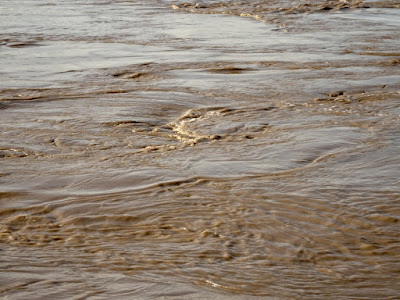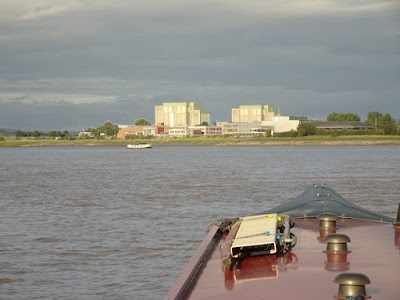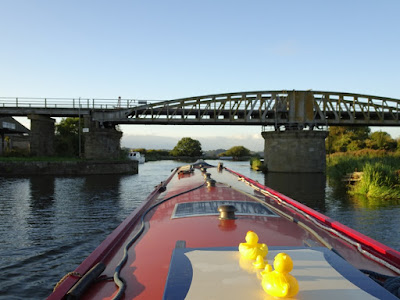So finally after a week's waiting we set off very early on Monday morning (21st August) on our adventurous narrowboating trip up to Sharpness. Our insurance company insisted that we have a pilot on the leg from Portishead to Sharpness and frankly, having done it, I'd never think of attempting this without a pilot. For the two hour cruise from Bristol to Portishead we could choose whether to take a pilot or not. The real concern is over the mile and a bit from the mouth of the River Avon to Portishead where to all intents and purposes you are navigating your narrowboat on the sea in an area where there are many huge commercial ships. As we were doing this for the first time, we decided to take a pilot for this leg as well. Having done that once we might do it again without but it was very reassuring to have the pilot here too. Overall it was a fantastic experience and we would certainly consider doing it again, but you do need fine calm weather.
So our morning departure was around 7 a.m. with the high tide due at Bristol at 07.47. Because we were in a period of spring tides the lock at Cumberland Basin was open both ends so we went out 'on a level'. In these circumstances the gates at Junction Lock between the Basin and the Floating Harbour are closed either side of high tide so we came through the previous evening and spent the night in Cumberland Basin.
Here we are following a cruiser through the fully open Cumberland Basin Lock. You can just make out the Clifton Suspension Bridge on the top right of the picture. As you can see it was a murky, drizzly morning but hardly any wind, which is good.
Once away from the lock you need some throttle and steer right to avoid being swept back up the New Cut by the incoming tide. But really that wasn't too difficult. Here we are passing the Hotwells landing to go under the Clifton Bridge.
Our pilot, Andy, looks very determined in this photo. Ian was steering Leo listening carefully to Andy's advice. The building in the background is the Gunpowder Wharf where incoming ships to Bristol were obliged to leave their guns and ammunition. Presumably to avoid trouble in Bristol Docks!
Surprisingly Andy's advice was to cut across the many bends in the Avon Gorge. As it was a spring tide there was plenty of depth to float a narrowboat even on the inside of the bends. On the left in the photo you can see the village of Pill and beyond is the M5 motorway bridge.
Here we are about to go under the motorway bridge. The narrowboat in front, Shammah, was travelling with us. He did not have a pilot. The big buildings seen through the bridge are in Avonmouth Docks.
A little further on we approached Avonmouth. If you look carefully between the buildings you can see a ship in the Docks.
The grassy spit is Nelson Point which we rounded and then headed alongside the wall behind which is Avonmouth South Pier. Any big ships going in should be on the other side of this pier.
Once we got near the end of the South Pier we turned sharp left and set out effectively to sea and across to Portishead. On the way you have to cross the entrance to Portbury Dock, another major commercial port. So you are crossing the path of huge commercial vessels. Liaison on the VHF with Bristol VTS (like Air Traffic Control for ships) is essential.
Shammah took a course a bit further out to sea than we did under Andy's guidance. The picture shows Avonmouth Piers (north to left and south to right) receding into the distance behind us. Too far out to sea here and you would be in the shipping lane.
Visibility was not good in the morning as you can see. The first pier sticking out is that by Portbury Dock and behind this you can just make out the headland beyond Portishead. The sea was mercifully calm. The idea is to pass quite close to Portbury Pier.
Portbury has the largest set of 'V' lock gates in the UK and you can see them between the tall lamp standards. At this point we had rounded Portbury Pier and were heading across the bay towards Portishead.
As we got closer the buildings of Portishead emerged from the gloom. We aimed for the prominent pointed tower to the right of the square tower blocks.
The tide by this point was ebbing fast down the Severn. A pier sticks out from the lock entrance and you have to be careful not to be swept past the pierhead. Shammah cut this pretty fine but Andy's guidance to us was to cut across away from the end of the pier. So we were fine. Once behind the pier the current dies away and life is easy.
Now we could throttle back and go gently down to the lock. We had been doing 2,000 rpm for an hour and a half. In the picture you can see the green, white, green vertical lights showing that the lock was ready for us to go straight in.
As it was close to high spring tide we only went up about 3 feet in the lock and then we were allowed out into the marina.
Here you can see Leo moored among big fancy cruisers. Not many narrowboats or broadbeams come this way. It is expensive to spend the night here (over £50 for our boat) but we were able to just wait for the next tide and this only costs £23.75.
So it was about 09.00 by the time we were tied up and we had to leave for the next tide at 16.30. We had a good look round Portishead and refreshed ourselves with a late breakfast at Wetherspoons. We also took the opportunity to check Leo over and found no problems.
Here is Helen sitting on the sea front. We should have been able to see Wales but the murk was slow to clear. Gradually the sun came out and views improved.
This is the view at low tide of the route we had followed coming into Portishead. The tidal range here is the third highest in the world at anything up to 50 feet!
This is the view looking towards the lock. No chance of a narrowboat getting through here now!
There was time for a bit of a rest too as we were up before 6 a.m. The clock crept on to 16.30 and we were off again, this time with a new pilot, Rick, who we picked up in the lock.
In good time we cruised up the marina before our booked lock time. You can see a Dutch Barge ahead of us called Bolberry. We cruised with them on this leg.
Our start time was about three and a half hours before high tide, so the lock took us a lot further down than on our arrival.
The radial gates opened and we were off. Other boats were waiting outside to come into the lock. Because the tide was lower we had to dodge left and right to avoid a sandbank that was well covered when we came in.
Beyond the pierhead, we steered a bit left to cross the shipping lane by aiming for these two buoys which mark the sides of the lane.
Looking towards Portbury Dock we saw this huge car carrier surrounded by three tugs. It was manoevring into the Dock.
As we crossed the shipping lane this dredger was bearing down on us and radioed to ask what we were doing. Rick reassured them that we were simply crossing the lane and in fact we were well clear before the dredger reached our track.
Here is the view looking back to Portishead. You can see that we are downriver from the pier this time.
Once across the shipping lane we could turn north east. The journey was a sequence of the pilot giving Ian points onshore or beacons in the river to aim for. The channel goes back and forth in a zig-zag fashion, sometimes on the Welsh side and then back to the English side. Here we are heading for the Second Severn Crossing.
Here is Rick, our pilot, who looks pretty relaxed. We are just passing under the Second Severn Crossing.
Ian, steering, wasn't quite so relaxed.
Between the two motorway bridges is the Shoots Channel. Here there are some fierce currents. Trying to keep Leo pointing where Rick asked was sometimes like helming a yacht in a strong breeze, you had to hold the tiller hard to one side against a strong force the other way.
Here are a couple of pictures of the swirls and eddies. You might think the water here is shallow but, according to Rick, it could be up to 10 metres deep! The incoming tide washes over deep channels in the sand and this causes the disturbances.
And here's another eddy. It's no wonder that Leo was difficult to keep straight in this water.
The Wye bridge at the end of the original Severn Bridge is really attractive from the water.
And the currents all die down as you approach the Severn Bridge. As you can see the weather was much better than the morning.
Here we are under the Severn Bridge. As we went under, Rick told us to steer left towards Wales. It looked as if we might hit the bridge pier but there was no chance given the speed we were going with the tidal current. Our top speed was 11.2 knots or almost 13 mph - by far the fastest Leo has ever travelled.
Helen was taking pictures while Ian wrestled with the tiller. Here you can see her shadow on the water.
By this point we were getting close to Sharpness and could just see the dock buildings in the far distance.
Here is Oldbury Power Station.
And this is Berkeley Power Station. You can see Bolberry ahead of us having turned along the shore after crossing from the Welsh side before us.
The prominent sandbank here has about a metre of water over it and amazing currents and boiling pots of water.
You wouldn't want to take your narrowboat across here!
Look at the speed of the tidal current here as it passes a navigation beacon. And you can see from the gauge that the water is nearly 4 metres deep.
At the right hand end of the sandbank you have to cross this turbulent water, though not as bad as you've just seen. Still pretty choppy for Leo. No slowing down here - just keep pressing on at 2,000 rpm to give as much steerage as possible. The tall building on the horizon is in Sharpness Dock.
And so for the final manoeuvre, the turning in at Sharpness. Here we were on a narrowboat travelling at three or four times its normal speed and we had to turn sharp right into safe water. All at full throttle too!
Two piers stick out either side of the entrance lock gates. At first it is difficult to make out that there are two piers as it all looks like one. Rick told Ian what to expect and said that he normally steers this bit. But he felt that Ian was up to the job!
Here you can see the two piers. Rick's advice was to shave close to the first and then turn in. But you need to be aware that the bow is then in still water while the stern remains in the fast flowing water. So you need to be careful using reverse tiller to make sure the boat is not flipped round to face downstream.
This was the close shave.
And here we are making the turn. In fact it wasn't as bad as Ian feared and the bliss of reaching still water was delightful.
See a smile as Helen uses the camera to look back out onto the river. From here all is calm and easy and we could even throttle back to usual speed for manoeuvring into the lock.
First you go through big gates into an outer basin and then from there into the lock. Some ships are too big to fit the lock and the outer basin then has to be used as a huge lock.
A little dredger was working in the outer basin, sucking up the mud through a pipe and dumping it in the river. First Bolberry and then Leo had to dodge round the dredger which was secured by chains to the sides. We had to wait while they dropped the chains onto the bed of the basin.
A last look out to 'sea' as we came into the basin .....
.... before we came into the lock and moored to Bolberry which in turn was tied to the side of the lock far above.
And so we were safe. The crossing from Portishead had taken two and a half hours, exactly as Rick had predicted. Three hours is more normal but it was a strong spring tide.
Here are the two boats with the lock nearly full. By now it was about 19.30, so near the end of a long day for us.
We left Rick at the lock and came out through the Docks.
Passing ships in a narrowboat is always novel.
The lock crew drove round the dock to open the low swing bridge for our two boats.
But the High Swing Bridge did not need to be swung as there is plenty of clearance.
After stopping on the visitor moorings we had a walk round to look at the Severn again and then returned to Leo to take this peaceful picture of the docks in the dying light of evening.
Did we enjoy the crossing? Yes we certainly did but conditions were ideal - light winds from the South and so calm seas all the way. It was not a cheap day. The Bristol Pilot (Bristol to Portishead) cost us £150 and the Gloucester Pilot (Portishead to Sharpness) cost £200. Mooring in Bristol is about £30 a night and in Portishead about £50 a night. We also followed advice and had our fuel tank and fuel cleaned (£90). But would we do it again? I think the answer is certainly yes.























































I've really enjoyed your account of this adventure. A bit too demanding for Out The Blue's engine and solo driver, but it's always good to aspire! Thank you. Kate, Blue and Lexi (ship's dog)
ReplyDeleteGreat commentary, Helen, we've almost relived our own trip last year. The close-ups of those whirl pools brought back vivid memories of the struggle passed the mouth of the Wye. Brave of you to make the trip clockwise: many have been stuck in Portishead waiting for better weather .... at £50 per night!!
ReplyDeleteWonderful pictures, it sounded like a fantastic journey :)
ReplyDeleteWow! Never knew you could do this.
ReplyDeleteWow! I never knew you could do this in a narrow boat.
ReplyDelete